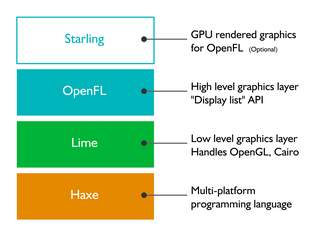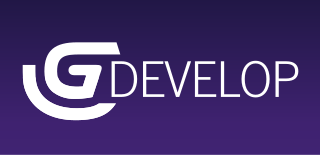Irrlicht is an open-source game engine written in C++. It is cross-platform, officially running on Windows, macOS, Linux and Windows CE and due to its open nature ports to other systems are available, including FreeBSD, Xbox, PlayStation Portable, Symbian, iPhone, AmigaOS 4, Sailfish OS via a QT/Qml wrapper, and Google Native Client.

Box2D is a free open source 2-dimensional physics simulator engine written in C++ by Erin Catto and published under the MIT license. It has been used in Crayon Physics Deluxe, Limbo, Rolando, Incredibots, Angry Birds, Tiny Wings, Shovel Knight, Transformice, Happy Wheels, and many online Flash games, as well as iPhone, iPad and Android games using the Cocos2d or Moscrif game engine and Corona framework.

Away3D is an open-source platform for developing interactive 3D graphics for video games and applications, in Adobe Flash or HTML5. The platform consists of a 3D world editor, a 3D graphics engine, a 3D physics engine and a compressed 3D model file format (AWD).

The Chromium Embedded Framework (CEF) is an open-source software framework for embedding a Chromium web browser within another application. This enables developers to add web browsing functionality to their application, as well as the ability to use HTML, CSS, and JavaScript to create the application's user interface.
MonoGame is a free and open source C# framework used by game developers to make games for multiple platforms and other systems. It is also used to make Windows and Windows Phone games run on other systems. It supports iOS, Android, macOS, tvOS, Linux, PlayStation 4, PlayStation 5, PlayStation Vita, Xbox One and Nintendo Switch. It implements the Microsoft XNA 4 application programming interface (API). It has been used for several games, including Bastion, Celeste,Fez and Stardew Valley.

Chukong Technologies is an international mobile entertainment platform company headquartered in Beijing. Chukong maintains four core business practices: game engine development, mobile game development, publishing, and developer community support. In January 2014, Chukong was named the third largest Chinese mobile developer. In addition to its headquarters in Beijing, Chukong Technologies also has offices in Menlo Park, Tokyo, Seoul, and Taipei.

OpenFL is a free and open-source software framework and platform for the creation of multi-platform applications and video games. OpenFL applications can be written in Haxe, JavaScript, or TypeScript, and may be published as standalone applications for several targets including iOS, Android, HTML5, Windows, macOS, Linux, WebAssembly, Flash, AIR, PlayStation 4, PlayStation 3, PlayStation Vita, Xbox One, Wii U, TiVo, Raspberry Pi, and Node.js.

Nim is a general-purpose, multi-paradigm, statically typed, compiled high-level systems programming language, designed and developed by a team around Andreas Rumpf. Nim is designed to be "efficient, expressive, and elegant", supporting metaprogramming, functional, message passing, procedural, and object-oriented programming styles by providing several features such as compile time code generation, algebraic data types, a foreign function interface (FFI) with C, C++, Objective-C, and JavaScript, and supporting compiling to those same languages as intermediate representations.
Crosswalk Project was an open-source web app runtime built with the latest releases of Chromium and Blink from Google. The project was founded by Intel's Open Source Technology Center in September 2013.
Universal Windows Platform (UWP) is a computing platform created by Microsoft and introduced in Windows 10. The purpose of this platform is to help develop universal apps that run on Windows 10, Windows 10 Mobile (discontinued), Windows 11, Xbox One, Xbox Series X/S, and HoloLens without the need to be rewritten for each. It supports Windows app development using C++, C#, VB.NET, and XAML. The API is implemented in C++, and supported in C++, VB.NET, C#, F# and JavaScript. Designed as an extension to the Windows Runtime (WinRT) platform introduced in Windows Server 2012 and Windows 8, UWP allows developers to create apps that will potentially run on multiple types of devices.
Stride is a free and open-source 2D and 3D cross-platform game engine originally developed by Silicon Studio. It can be used to create video games for PC, mobile devices and virtual reality.
FlatBuffers is a free software library implementing a serialization format similar to Protocol Buffers, Thrift, Apache Avro, SBE, and Cap'n Proto, primarily written by Wouter van Oortmerssen and open-sourced by Google. It supports “zero-copy” deserialization, so that accessing the serialized data does not require first copying it into a separate part of memory. This makes accessing data in these formats much faster than data in formats requiring more extensive processing, such as JSON, CSV, and in many cases Protocol Buffers. Compared to other serialization formats however, the handling of FlatBuffers requires usually more code, and some operations are not possible.

Phaser is a 2D game framework used for making HTML5 games for desktop and mobile. It is free software developed by Photon Storm.
LÖVE is a free, open-source, cross-platform framework released under the zlib license for developing video games. The framework is written in C++ and uses Lua as its scripting language and is still maintained by its original developers. The framework is cross-platform supporting the platforms Microsoft Windows, macOS, Linux, Android, and iOS.

GDevelop is a 2D and 3D cross-platform, free and open-source game engine, which mainly focuses on creating PC and mobile games, as well as HTML5 games playable in the browser. Created by Florian Rival, a software engineer at Google, GDevelop is mainly aimed at non-programmers and game developers of all skillsets, employing event based visual programming similar to engines like Construct, Stencyl, and Tynker.

Aseprite is a proprietary, source-available image editor designed primarily for pixel art drawing and animation. It runs on Windows, macOS, and Linux, and features different tools for image and animation editing such as layers, frames, tilemap support, command-line interface, Lua scripting, among others. It is developed by Igara Studio S.A. and led by the developers David, Gaspar, and Martín Capello. Aseprite can be downloaded as freeware, or purchased on Steam or Itch.io. Aseprite source code and binaries are distributed under EULA, educational, and Steam proprietary licenses.

Defold is a cross-platform, free, and source-available game engine developed by King, and later the Defold Foundation. It is used to create mostly two-dimensional (2D) games, but is fully capable of three-dimensional (3D) as well.









